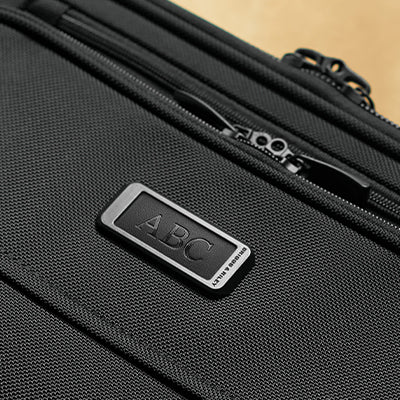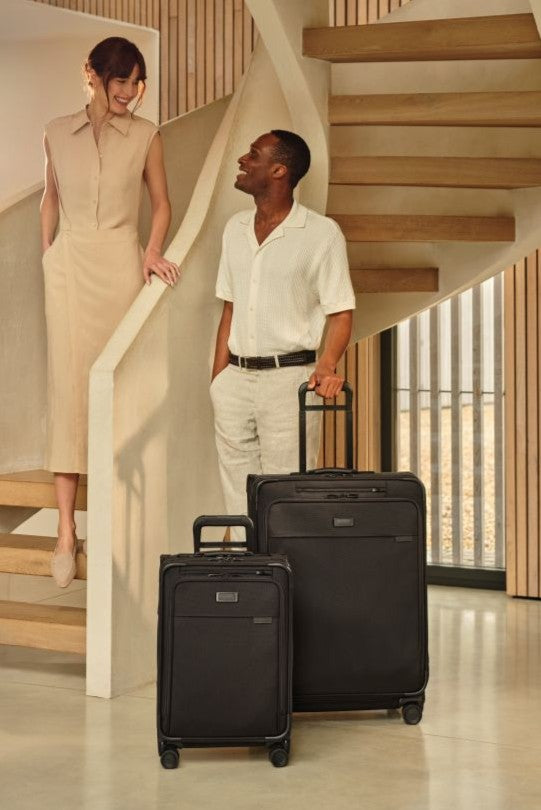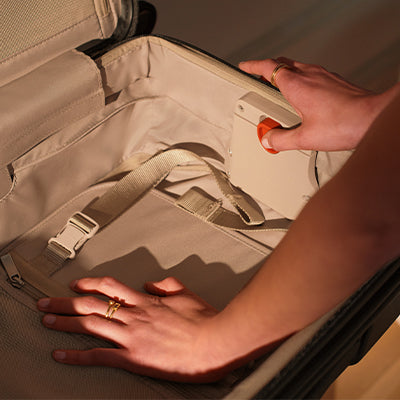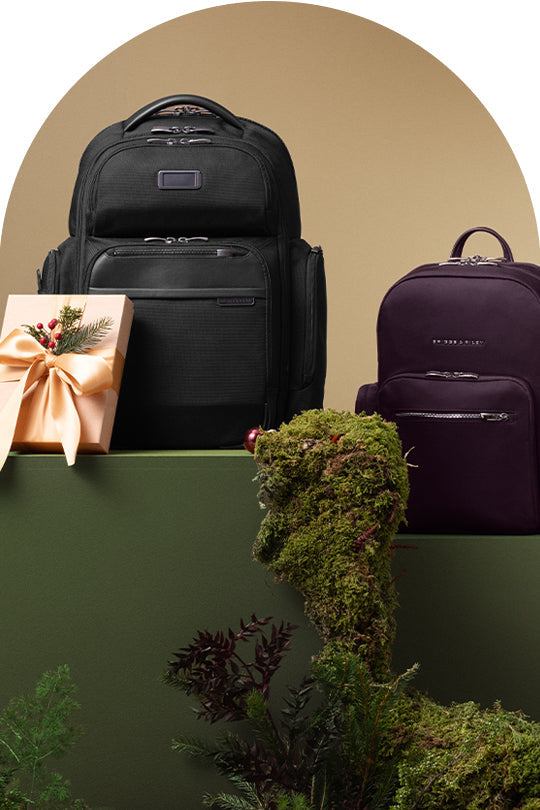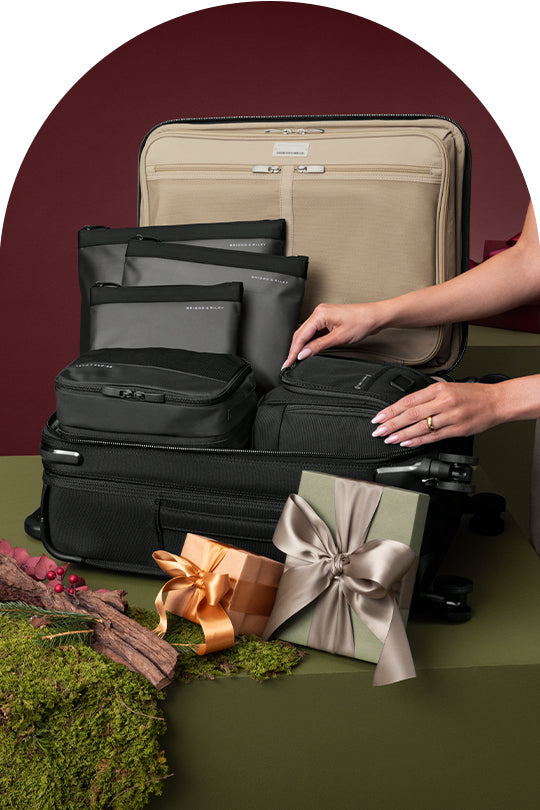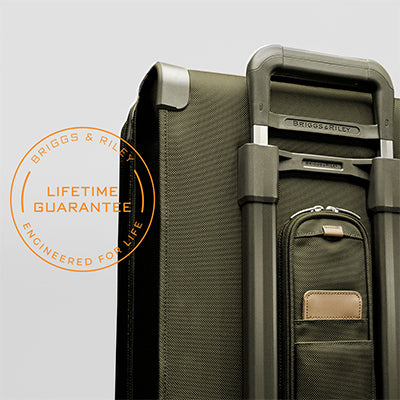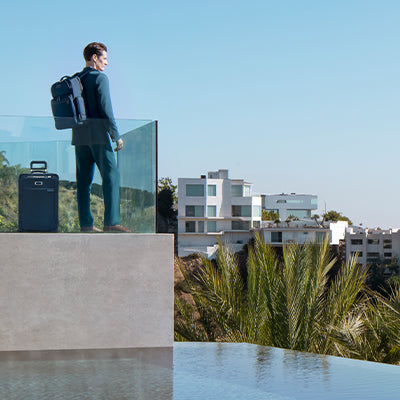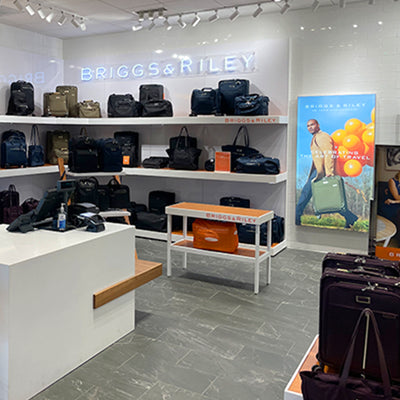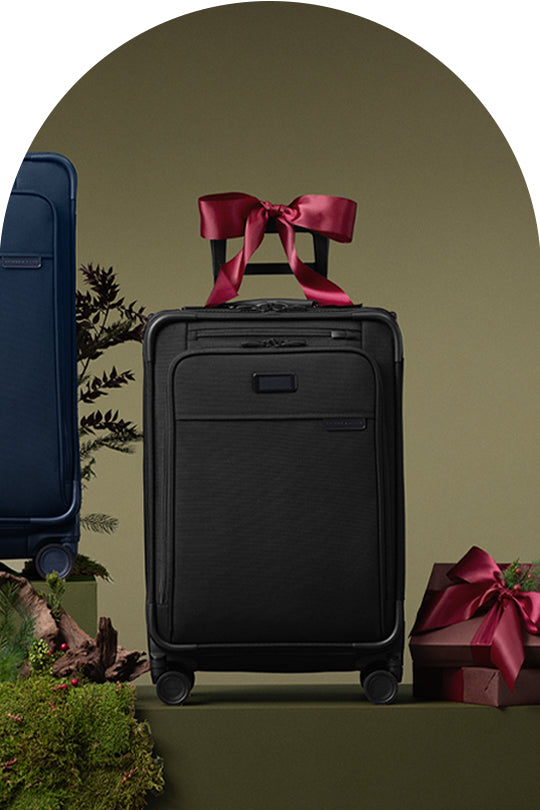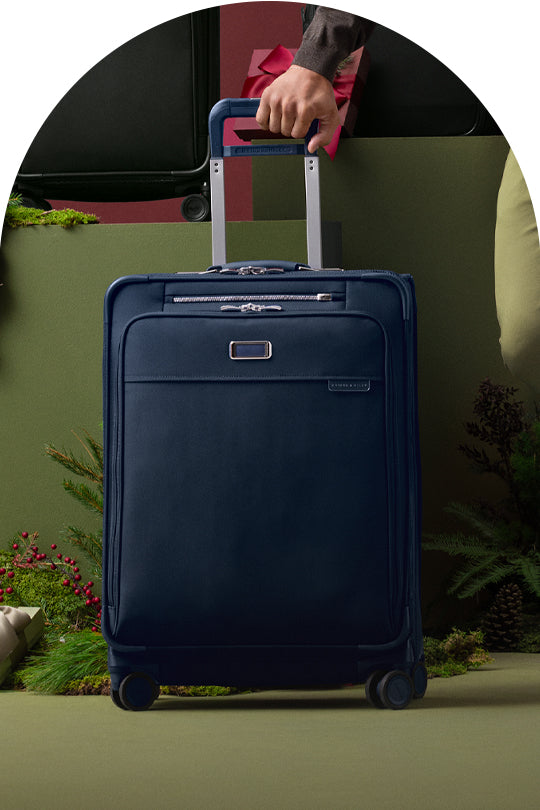What Can You Take on a Plane? Your Guide to Hand Luggage Restrictions and Rules
Packing your hand luggage used to be simple. A book, your toothbrush, maybe a jumper for the plane. These days, with airport security tighter than ever, the question on every traveller's mind is: what can you take on a plane?
If you've ever found yourself unpacking your carefully packed bag at the security desk—or worse, waving goodbye to your favourite moisturiser—you're not alone. Hand luggage restrictions are strict, but they don't need to be confusing.
This guide will walk you through current regulations, so you know exactly what's allowed and what's better left at home. We'll also see how Briggs & Riley's cabin luggage simplifies your travel experience.
Understanding Hand Luggage Restrictions
Airlines might let you bring a bag into the cabin, but airports are where the real rules kick in. Hand luggage restrictions exist because anything you bring into the cabin travels with you—within arm's reach. That's why liquids, sharp objects, and oversized electronics get so much attention.
The UK follows strict security protocols for hand luggage. The goal: stop dangerous items from reaching the cabin, without slowing every traveller to a crawl. Unfortunately, this creates a long list of dos and don'ts.

Hand Luggage vs. Checked Baggage: What's the Difference?
Your checked baggage goes in the hold and sees far less scrutiny at security. Your hand luggage, however, gets scanned, screened, and sometimes searched.
That's why hand luggage restrictions are tighter. Items perfectly fine in your checked bag (like large liquids, tools, or certain batteries) won't make it through in hand luggage. Knowing this saves you hassle—and keeps your favourite items from being binned at the gate.
The Most Common Hand Luggage Mistakes Travellers Make
Every airport has seen it all:
- Full-size shampoo bottles getting confiscated.
- Penknives forgotten in backpacks.
- Power banks left loose in a tangle of cables.
- Bags packed to bursting, impossible to reseal after inspection.
Travellers often assume small personal items won't be an issue, but security scanners are thorough. Understanding hand luggage restrictions means fewer surprises—and a much smoother airport experience.
Liquids, Toiletries, and the Infamous 100ml Rule
Airport hand luggage liquid limits are famously strict. Every liquid, gel, paste, cream, or spray must be in a container no larger than 100ml. All those containers need to fit into a single, transparent, resealable plastic bag—no bigger than 20cm x 20cm.
To be clear, it's not just water and drinks. Toothpaste, mascara, lip balm, jams and honey, even soft cheese counts as a liquid. Many travellers get caught out by this.
Hand Luggage Liquid Allowance: The Official Line (and Real-World Tips)
Your hand luggage liquid allowance is limited to one small bag per person. That's around a litre in total capacity, but space is the real enemy here. Overstuffed bags won't get through security, and airport staff won't hesitate to bin excess items.
Smart travellers use solid toiletries to sidestep these limits—solid shampoo bars, stick deodorants, toothpaste tabs, and bar soap are all security-friendly and suitcase-friendly. Another top tip: decant your liquids into reusable 100ml bottles well before your trip. Airport shops sell them, but they're often overpriced.
If you plan to do laundry on your trip, pack laundry detergent sheets. They're compliant, take up next to no room, and wash clothes nicely.
Clear Bags: What Works at the Airport
Freezer bags from the supermarket might pass in a pinch, but they're flimsy and often get rejected. A sturdy, zip-top clear pouch designed for air travel is a safer bet. Reusable options are better for the environment and less likely to split open mid-security check.
Some airports even hand out compliant bags, but it's best not to rely on this. Bring your own and save yourself the scramble.
Explore the Art of Travel
Always Enhancing the Travel Experience
What Can You Take in Hand Luggage?
There are a number of items that you can take in your hand luggage, including sewing needles and knitting needles.
Can You Take Tweezers in Hand Luggage?
Yes, you can—tweezers are allowed in hand luggage at the airport. But there's a catch: they must be blunt-ended or small enough not to be considered a weapon. Most cosmetic tweezers are fine. That said, security staff have the final say. If officials think your tweezers could pose a risk, they'll be taken off you.
Can You Take Scissors in Hand Luggage?
Scissors are allowed in hand luggage, as long as the blade is no longer than 6cm from the fulcrum (that's the pivot point where the blades meet). Small cosmetic scissors for nails or grooming usually pass the test. Anything larger is best left in your checked bag.
Can You Take Razors in Hand Luggage?
This one trips people up. Razors are allowed in hand luggage, but only certain types. Disposable razors (the kind where the blade is moulded into the plastic head) are fine. Cartridge razors like Gillette are also allowed. Loose razor blades? Absolutely not. Those belong in checked baggage—or better yet, at home.
Can You Take Aerosols in Hand Luggage?
Aerosols are allowed in hand luggage, provided each can is 100ml or smaller and fits within your liquid allowance bag. This includes deodorant, hair spray, and shaving foam. Remember, aerosols count towards your overall hand luggage liquid limits. No sneaky full-size cans allowed.
Other Personal Items To Watch Out For
Travellers often forget items like nail files, corkscrews, and lighters fall under hand luggage restrictions. Small nail files are usually fine, but corkscrews with blades are confiscated on sight. As for lighters, you're allowed one per person, and it must stay on your person—not in your bag.

Electronics and Security Screening
Laptops, tablets, and e-readers, are all allowed in hand luggage, but you must remove them from your bag and place them in a separate tray at security. Power banks and spare lithium batteries should also be declared if asked. Smaller items—phones, chargers, headphones—can usually stay in your bag, but if your luggage triggers an alert, they may be pulled out for inspection.
Make sure your electronics are fully charged, because security officials may ask you to turn them on.
Pro tip: Pack your electronics in an easy-access section of your hand luggage. Nothing slows you down more than rummaging through a tightly packed bag while the queue behind you groans.
Are Power Banks Allowed in Hand Luggage?
Yes, power banks are allowed, but they come with conditions. They must travel in hand luggage, not checked baggage. The limit is usually 100Wh, though some airlines allow up to 160Wh with prior approval. Check your power bank's label before you fly. No label? Expect questions.
Charging Cables, Headphones, and Other Essentials
Cables, wired headphones, and other small electronic accessories can stay packed, but it's smart to keep them organised. Use a tech pouch to avoid the classic "tangle of doom." Wireless earbuds are fine too, though you'll need to remove them for security checks if requested.
Layout Hacks That Work
Here's how frequent flyers breeze through security:
- Place your liquids bag and electronics at the top of your hand luggage for quick removal.
- Avoid overstuffing your bag. Overfilled compartments look suspicious on scanners.
- Use packing cubes to separate clothes from electronics and toiletries.
- Have your boarding pass ready—digging through pockets wastes precious seconds.
A little preparation saves you from the dreaded secondary bag check.
What Am I Not Allowed To Carry in My Hand Luggage?
The list of prohibited hand luggage items is longer than most people expect. Here are the usual suspects you cannot take past security:
- Firearms and anything resembling one (yes, even toy guns).
- Explosives, flares, fireworks, and sparklers.
- Knives, blades, and sharp tools over 6cm.
- Loose razor blades (as mentioned earlier).
- Self-defence sprays (like pepper spray).
- Work tools that could double as weapons (hammers, spanners, screwdrivers over 6cm).
- Sporting bats, cues, and clubs.
If it could be used as a weapon or cause chaos in a confined space, it's staying behind.

Items Travellers Often Forget Are Restricted
A few everyday items still catch people out:
- Snow globes (they count as liquids and are rarely under 100ml).
- E-cigarette refill bottles—these must follow liquid limits.
- Cans of compressed air (used for cleaning electronics).
- Tent pegs and camping equipment with sharp edges.
Souvenirs, Duty-Free, and Airport Exceptions
Buying duty-free after security? Fine. But remember, if you're transiting through another country, their rules apply too. Always check liquid limits for connecting flights.
Liquids bought airside (after security) are exempt from the 100ml limit but must remain sealed in tamper-evident bags. Unsealed bottles can be confiscated at connecting airport security checks.
How Security Handles Questionable Items
If security isn't sure about an item, they'll scan it again or do a manual search. You might be asked to unpack your bag. Be polite, be patient. Security staff have final authority, and arguing rarely ends well.
If your item is deemed unsafe, you won't be allowed to take it. Options are limited: bin it, post it home (if the airport offers this), or surrender it and move on.
What Items Are Allowed on a Plane in Hand Luggage: The Essentials Checklist
Packing hand luggage shouldn't feel like a gamble. Here's a no-nonsense checklist of items you can bring into the cabin without grief from security:
- Toiletries and small aerosols (deodorant, shaving foam) within the liquid limits (100ml containers, packed in a clear 20 cm x 20 cm bag)
- Tweezers, scissors (blades under 6cm), disposable razors
- Personal medication (with prescription if needed)
- Baby food, formula, and breast milk (no limit, but your baby must be present)
- Laptops, tablets, e-readers, phones, power banks (within airline limits)
- Chargers, headphones, travel adaptors
- One lighter per person (must stay in your pocket)
- Snacks and non-liquid food
- Books, magazines, and small personal items
Things That Can Stay Packed
Items like clothing, shoes, books, and non-electronic accessories stay zipped up in your bag. You don't need to remove them at security unless your bag gets flagged.
Pack with Purpose To Breeze Through Security
Organisation is everything. Place liquids and electronics where you can reach them fast. Pack no-go items in your checked baggage (or leave them home). If you're unsure about a specific item, check with your airline before you fly. It's faster than explaining to security later.
Smooth Travels Start with Smart Packing
Knowing what you can take on a plane is half the battle. The other half? Packing well. Security isn't out to ruin your trip, but rules are strict—and they're not budging for your oversized toothpaste or forgotten penknife.
By understanding hand luggage restrictions, respecting liquid limits, and staying organised, you'll breeze through security while everyone else fumbles around. Small tweaks—like switching to solid toiletries or packing electronics for easy access—make a huge difference.
Think of it this way: the less time you spend unpacking at security, the sooner you're relaxing airside with a coffee.
The Right Hand Luggage Makes Airport Security a Breeze
Cutting through airport faff starts with the right bag. Briggs & Riley's carry-on luggage collection takes the stress out of security with smart compartments, thoughtful organisation, and rock-solid durability. No more fumbling for your liquids or digging for your laptop while the queue builds behind you.
Designed for frequent travellers who know better, our cabin luggage handles the demands of modern air travel and looks sharp doing it. Plus, with a lifetime guarantee, it’s the last cabin bag you’ll need to buy.
Frequently Asked Questions
Even seasoned travellers have last-minute questions about hand luggage restrictions. Here are quick answers to the things people ask most—so you can avoid surprises at the airport.


